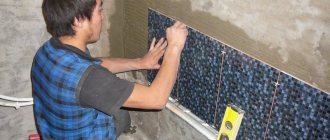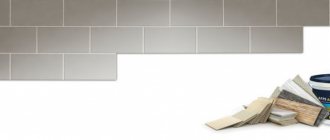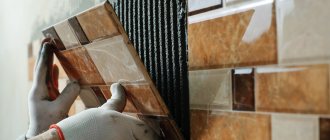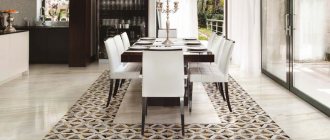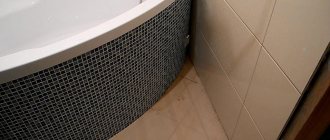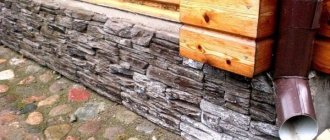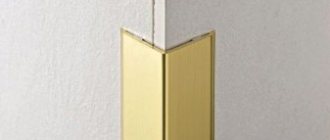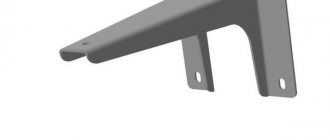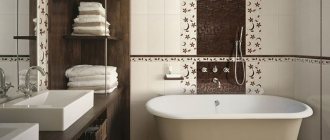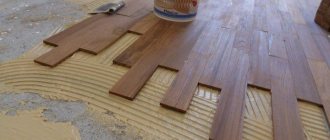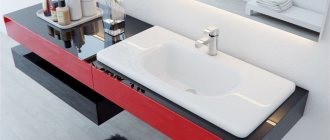The influence of the scheme on the interior
The layout scheme affects the impression of the interior. Indoor renovation work begins with the selection of flooring materials. In accordance with the tiles, skirting boards, borders and other design elements are chosen to create an original design.
The rules for laying out tiles affect the consumption of materials, since the schemes require different numbers of finishing products per 1 square meter. m. Direct laying is the most economical. Combined, chess and other complex compositions require greater consumption of materials. When designing non-traditional schemes, additional processing of elements and the purchase of auxiliary parts are required.
The placement method and texture of facing products visually change the size of the rooms. Horizontal installation with textured seams visually expands the room, but reduces its height. The use of vertical tiles in the bathroom optically narrows the space. The herringbone laying method will help in visually expanding the room if you select narrow elements. A scheme using massive square-shaped materials will visually make the spacious room smaller.
Using different shades will create bright accents when decorating the floor. The inclusion of elements of contrasting shades in the masonry will introduce elements of modernism style into the interior. Laying wood-effect tiles in a herringbone pattern will give the surface a resemblance to parquet flooring. Marble facing elements, laid out like parquet, can be the main covering or accent inserts.
Porcelain tiles and inserts in the ART REAL salon
The ART REAL salon offers a wide selection of porcelain tiles for installation with inserts: plain, with a “stone” and “wood” pattern. You can also buy metal decorative inserts from the Kavarti factory from us.
You can view samples from your favorite collection of porcelain tiles in the showroom of the salon - we are open every day!
Tags: Italon , Peronda , Atlas Concorde , Tiles , Ceramic tiles , Porcelain tiles , Wood effect , Marble effect , Inserts , Rex , APE , Imola Ceramica , Cir & Serenissima , Equipe , Equipe Octagon , Ceramic parquet , Borders , bronze , Floor , Herringbone , Ariana Convivium , Italon Charme , APE Liguria , Peronda Marmara , Ceramic Inserts , Porcelain tiles Under Inserts , Octagonal , Cir & serenissima Taiga , Petracers Carnevale Veneziano , Rex I Bianchi , Kavarti , Atlas Concorde Unica , Imola Ceramica Pompei , Metal Inserts , Smooth , Embossed, Brass, Laying, Italon Prestige
The tiles are scattered
The staggered pattern is an installation of rectangular elements with every second row offset by half the width of the tile. The result will be a beautiful pattern, similar to brickwork. For original design solutions, the square shape of the elements can be used, which will create an unusual visual effect.
Laying tiles in staggered patterns is recommended for high-traffic areas of the apartment - kitchens and hallways. With this method, tiles are laid out only horizontally. The pattern with imitation brickwork creates a special atmosphere in the interiors. Glossy rectangular elements laid out staggered are suitable for rooms decorated in retro style. Brown tiles with scuffs are used in country style designs.
Alternation
The situation can be corrected by alternating products with different parameters. In this case, the tiles are laid one after another - first with a larger size, then with a smaller one. In the next row you need to start with a shorter product. Crosses should be used everywhere of the same size, as a result the gaps between the rows will be even. A well-chosen grout will finally smooth out minor defects.
Herringbone styling
The installation of herringbone elements is similar to parquet flooring. The method is difficult to implement, but quite original. The scheme assumes precision in the fitting of elements. This option for laying tiles is common when installing rectangular products. The technique involves joining the narrow side of the facing material with the wide one. The process creates 90° angles.
The most harmonious laying is in a herringbone pattern when using different shades of the same color, including the possibility of imitation of natural materials (wood, stone). The installation option is optimal for floor coverings in rooms of irregular shape, since the herringbone optically evens out the difference in size.
The herringbone laying pattern is single, when each subsequent tile is joined to the adjacent one. With a double herringbone pattern, there are two rectangular elements in each row. Triple laying resembles weaving, as three fragments are used to create each level.
Diagonal
Laying diagonally (rhombus) repeats the classic straight layout in everything, except for the direction. Placement of materials is carried out at an angle of 45 degrees relative to the walls. With this pattern, square tiles look best. The cladding will have to be cut along the edges near the wall line.
Diagonal layout of tiles on the floor is popular. On walls, the same scheme is used less frequently - when creating small areas with a color or texture accent. Before laying the tiles in a diamond shape, it is necessary to prepare calculations and mark out a composition plan.
The scheme is suitable for small rooms, as it allows you to visually expand the room. The advantage of placing elements diagonally is that it helps disguise unevenness. It is necessary to take into account the high consumption of materials, since the cladding adjacent to the edge needs to be leveled.
Features of choosing tile size.
It has already been said that the size of the tiles, especially for a small bathroom, is of great importance. You need to choose large tiles and try to lay them without cutting them. On sale you can find tiles of a solid size; they are laid quickly, but are not always convenient for transportation.
When considering medium-sized tiles, if possible, you should choose rectangular tiles and place them horizontally. Here, the technique of laying it in a dressing, like a brick one, will be successful.
It is not recommended to use small tiles, unless for modular installation, or when decorating a niche or other elements of the composition. Small mosaic tiles in the interior of a small bathroom can become an element of decoration for a cabinet or podium for a bathtub, for other plumbing fixtures - visually the size of these elements will decrease and the space of the room will expand.
In general, the size and shape of the tiles should be chosen based on the shape and characteristics of a particular room. In an elongated bathroom, you can even out the dissonance by combining rectangular tiles on narrow walls, and square ones on long walls, of the same color or even different ones.
It is difficult to design a room limited by small dimensions; you have to resort to many tricks that complicate the work, and if you are afraid to carry out the idea yourself, contact professionals - designers and tilers. In this case, your costs will be justified, and the result will delight your household.
Use of multi-format products
Combined products can be used in installation: different formats, shades, colors. The herringbone pattern on the floor is combined with a diagonal tile pattern on the walls, large elements are mixed with small ones, etc.
The technology for laying tiles of different formats is difficult to implement and requires accurate calculations and drawings. When creating a scheme, it is necessary to take into account the dimensions of all elements, the width of the seams, and the color scheme.
An original combination of tiles of different shades of the same color; multi-color compositions with proper selection are also possible. For complex authoring solutions, it is recommended to seek advice from specialists. An easier option is to purchase ready-made combinations of facing elements.
What thickness of porcelain tiles with dimensions 600x600 is optimal?
Comparative characteristics of the indicators of ordinary tiles and porcelain stoneware of different thicknesses.
600x600 tiles have a fairly variable thickness - from 7 to 15 mm. Usually a universal thickness of 10 millimeters is used. But the choice of thickness also depends on the goals:
- For not very busy surfaces (wall decoration), tiles up to 10 mm are used.
- Floor tiles 600x600 porcelain stoneware should have a stronger structure and material; it is recommended to choose a thickness of 12 mm or more. The final thickness is selected based on cross-country ability. In public places, the thickest 600x600 granite modules are used, because under intense loads they can quickly fail.
What does thickness depend on? First of all, the thickness of the material is influenced by the structure. When using tiles of different textures, the interior design will vary. Depending on the surface coating of the tiles, the following varieties are distinguished:
- Homogeneous. Such modules for 600x600 cm granite are painted completely; they are a classic option, where the coloring element is the pigments used in the mass of 60x60 cm granite tiles. Thanks to the paint contained throughout the entire thickness, 600x600 ceramic tiles retain their color. Even with uneven abrasion it will not be noticeable.
- Partially painted. Usually there are two layers: a substrate and a pigment. The substrate is made in a classic light color and contains dark inclusions (this range is called “salt-pepper”). The top layer is painted. This type is cheaper because paint is used economically.
- Glazed. They are similar to regular 60x60 floor tiles, but have improved qualities.
Chess at an angle and without
Checkerboard masonry is popular when decorating floors, walls, and objects. The point of the method is to use elements of two contrasting colors to create a composition.
When laying in a checkerboard pattern, you can alternate the size and texture of the facing products and their location. Tile layout options are possible using elements of the same color, but in different shades. The color perception of the composition will be softer.
Checkerboard laying can be diagonal, in which case the elements are located at an angle. This design option looks good on the bathroom floor. Both square and rectangular cladding are acceptable.
Tile color in small bathroom design.
Questions about choosing a design and color are often thought-provoking, since the available color range is further expanded by the ability to choose tiles with different patterns, panels or photo printing. Limited bathroom space can be used in different ways. Some people choose light colors for the entire room, while others expand the space by playing with contrast. Monochromatic, boring designs are no longer pleasing to the eye, so you can experiment.
Previously, there was a very categorical attitude towards deep rich tones, black, red or orange. But these are all prejudices and attempts by political figures to limit the population, deprive them of their will, and suppress them. Bright, saturated colors can and should be used, but not as the main, dominant background, but as accents.
By combining the incongruous, you can achieve very incredible solutions in bathroom design, and you can expand the space with the help of other tricks, for example, by making cabinets hidden under the bathroom, or raising it to the podium and making maximum use of the walls.
Linen carpet
Masonry in the style of “canvas carpet” is the design of part of the room using color schemes and a combination of elements. This creates an accent in the desired part of the house. The scheme will look impressive in spacious halls.
The laying pattern involves a combination of cladding of different sizes and colors. For a linen carpet, elements with a pattern are also used. A very important stage in the implementation of technology is creating a project on paper. Then the finished diagram is transferred to the surface using markings. For complex compositions, it is better to consult a designer. You can also use ready-made kits, which come with instructions and drawings.
What types of inserts are there?
Some porcelain tile collections, for example, Italon Prestige or Ariana Convivium, contain ceramic inserts that match the main tile in color, texture and thickness. If they are not in the collection, you can separately purchase decorative metal inserts - brass or bronze . Metal inserts come in different sizes, plain and colored, smooth and embossed.
The size of the inserts usually varies from 3 to 8 cm; the larger the format of the main tile, the larger the inserts can be used.
Pictured: Kavarti metal inserts.
